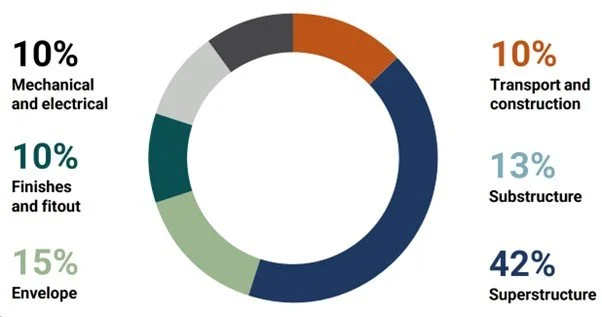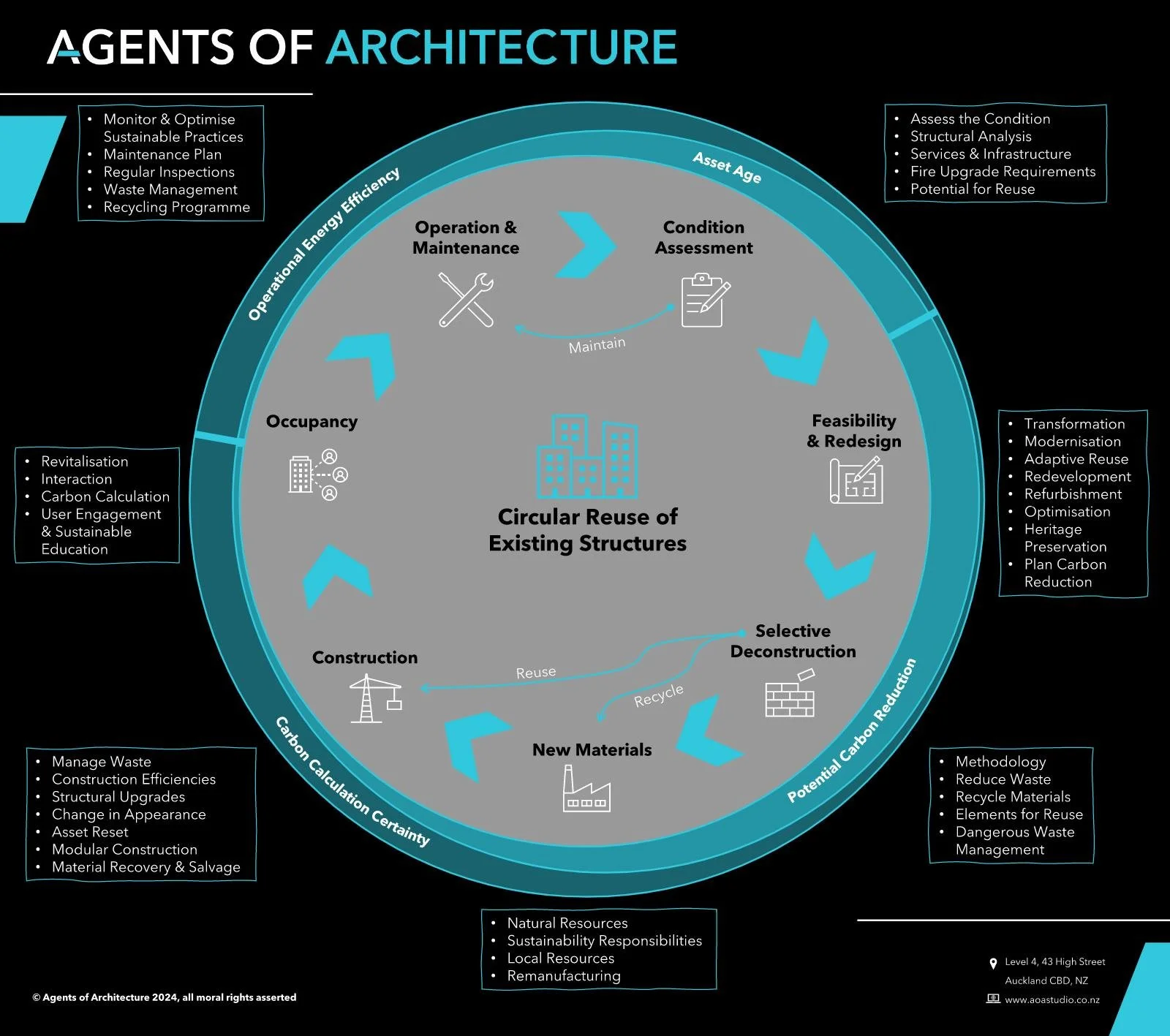Sustainable Initiatives: Reusing Existing Buildings
In the pursuit of a more sustainable New Zealand, the conversation often revolves around renewable energy consumption, waste reduction, and achieving net-zero carbon emissions. While these initiatives are vital in all areas, in the architecture, engineering, and construction (AEC) sector one often overlooked aspect of sustainability can substantially support these initiatives; reusing existing buildings.
Refurbishment involves the renovation or improvement of an existing building or structure, typically involving repairs, upgrades, or aesthetic enhancements to extend its lifespan and functionality. Another way to reusing existing buildings is through adaptive reuse, which is the process of repurposing an existing building or structure for a use other than what it was originally designed for, while retaining and often creatively incorporating its original features. The refurbishment or adaptive reuse of existing building presents an opportunity to drive sustainability forward while fostering economic growth.
In this article, Agents of Architecture will share our expertise on sustainable initiatives, transformative potential, and revitalisation benefits of existing buildings.
Economic and Sustainable Benefits
The pursuit of sustainability is typically considered costly; however, the reuse of existing structures presents a financially viable alternative to demolition and new construction. The cost of constructing new buildings is often higher than the expenses associated with refurbishment. By leveraging the existing structure and infrastructure, projects can yield significant cost savings.
Reuse and refurbishment of existing buildings promotes a circular economy, where the focus is on conserving resources, minimising waste, and extending the life cycle of products and structures. Instead of demolishing or constructing new buildings, which requires enormous amounts of energy, raw materials, and waste, reuse allows us to harness the embodied energy already invested in these structures.
This synergy between economic and sustainable benefits creates a successful scenario for both viability of the project and environmental concern.
Reducing Embodied Energy and Carbon
Embodied energy refers to the total energy consumed throughout a building's lifecycle from the extraction and processing of raw materials to manufacturing, transportation, and construction. Demolishing a building prematurely discards this embodied energy, leading to unnecessary resource depletion and increased waste generation. Reuse, on the other hand, leverages the existing infrastructure, minimizing the need for new raw materials and the associated energy expenditures.
Embodied carbon refers to the total amount of greenhouse gas emissions associated with the production, transportation, and installation of materials and components used in the construction of a building or infrastructure project. It includes emissions from both direct and indirect sources throughout the entire life cycle of these materials. Refurbishment often involves reusing existing building materials, which significantly reduces the need for extracting new resources and the fabrication of new materials. This practice lowers the embodied carbon associated with producing and transporting these materials.
The durability of various building components differs, with the superstructure and substructure contributing to over 50% of the upfront carbon while also exhibiting the longest lifespan. Extending the longevity of these high-carbon elements, such as concrete and steel, helps minimize the requirement for replacements and decreases the initial carbon emissions linked to new construction.
Addressing embodied energy and embodied carbon is vital for comprehensive sustainability. Extending the lifespan of an existing building lowers its overall energy consumption and carbon footprint.
Figure 1: Typical breakdown of upfront carbon in a new office building.[i]
Environmental Stewardship
The avoidance of greenfield development and the preservation of the landscape are integral aspects of reusing existing buildings. Greenfield development, characterized by building on undeveloped land, often results in habitat disruption, loss of biodiversity, and increased infrastructure demands. By repurposing and upgrading existing buildings, we can substantially reduce the ecological footprint associated with construction, preserving valuable resources, and mitigating environmental degradation. This strategy aligns with principles of resource conservation, as it preserves valuable landscapes, mitigates urban sprawl, and fosters a responsible use of built assets, embodying a holistic commitment to environmental stewardship.
Energy Efficiency Enhancement
One of the most significant advantages of refurbishing existing buildings is the opportunity to enhance energy efficiency. Older structures often lack insulation, utilize outdated heating and cooling systems, and have inefficient lighting. Through retrofit design, we can introduce smart building technologies that optimize energy use, such as thermal windows, increased insulation, and HVAC systems, significantly reducing energy consumption, associated carbon emissions, and occupant comfort.
Electrification is the process of transitioning from non-electric power sources to the use of electricity, particularly in the context of replacing traditional combustion-based systems with electric alternatives. We maximise electrification, allowing for the integration of high-efficiency electric systems, such as heat pumps, LED lighting, and low consumption appliances, that also contributed to overall cost savings.
The seamless integration of renewable energy generation, such as solar power generation, further reducing dependence on non-renewable energy sources. The impact of these improvements contributes to the overall reduction of greenhouse gas emissions.
Cultural, Heritage and Social Benefits
Reuse of existing buildings allows the industry to adapt to changing social and economic conditions, such as population shifts, urbanization, or evolving markets. It provides a flexible and responsive approach and can contribute to the economic revitalization of urban areas, attracting businesses, residents, and visitors.
Adaptive reuse and refurbishment of existing buildings revitalizes communities and preserves cultural heritage. Renovated buildings can serve as focal points for community development, bringing new life into neighbourhoods and stimulating local economies. By repurposing historic buildings, we preserve our cultural heritage while creating unique spaces that honour the past and inspire the future. This blend of sustainability and cultural preservation fosters a sense of pride and identity within communities, enhancing social cohesion and well-being.
Governments and organizations around the world are implementing incentives and policies to encourage sustainable renovation. Additionally, the New Zealand Building Code and standards are being updated to prioritize energy efficiency and sustainable practices. The NZGBC’s Green Star programme has provided a rating system to certify sustainability credentials and introduced a benchmark for the operational performance of existing buildings to assist in reducing the built environments 20% contribution to New Zealand’s emissions.[ii]
Sustainable themed and ethical investment has also arisen, as a result of a rising concern over the impact of companies on individuals and communities. Consumers are now far more conscious about the impact of their purchases and looking to invest in companies with high ethical standards. These supportive measures empower individuals and organizations to embrace refurbishment and to drive sustainability.
How We Review What To Reuse
The process of reusing an existing building is complex and takes a great deal of expertise. We coordinate a team of consultants to gather the information to inform the viability of the project and identifying what elements are for reuse. Together we conduct an assessment by reviewing the structural stability, weathertightness, condition of services, fire requirements, planning regulations and the potential for the proposed use. We then plan significant reductions in upfront carbon through material selection and planned reuse through the design process.
Figure 2: Agents of Architecture's plan for circular reuse of existing structures.
Towards a More Resource Efficient New Zealand
The reuse of existing buildings as a sustainable development, offers a multitude of benefits for the environment, communities, and economies. Refurbishment and adaptive reuse projects have the power to transform our urban landscapes, revive cultural heritage, and foster sustainable growth. As we continue our journey towards a greener future, let us recognise and harness the potential of existing buildings as a vital component of our sustainability efforts. Together, we can build a more resilient, resource-efficient, and inclusive New Zealand for generations.
If you would like advice on how to apply sustainable practices to your reuse project, contact Agents of Architecture.


